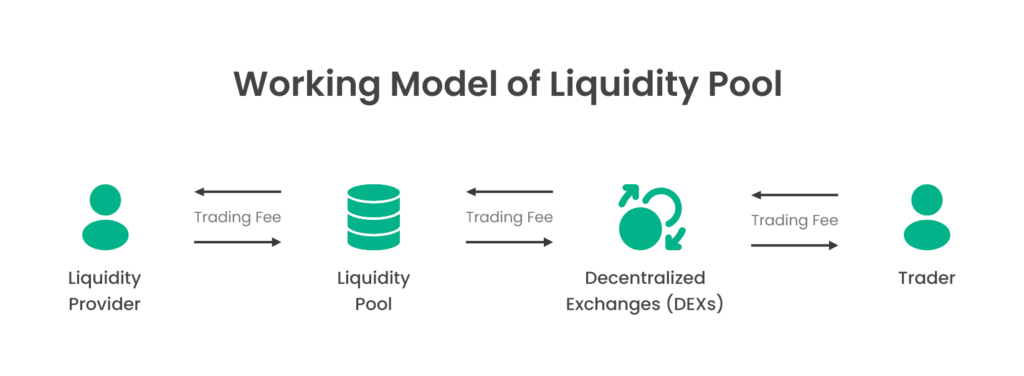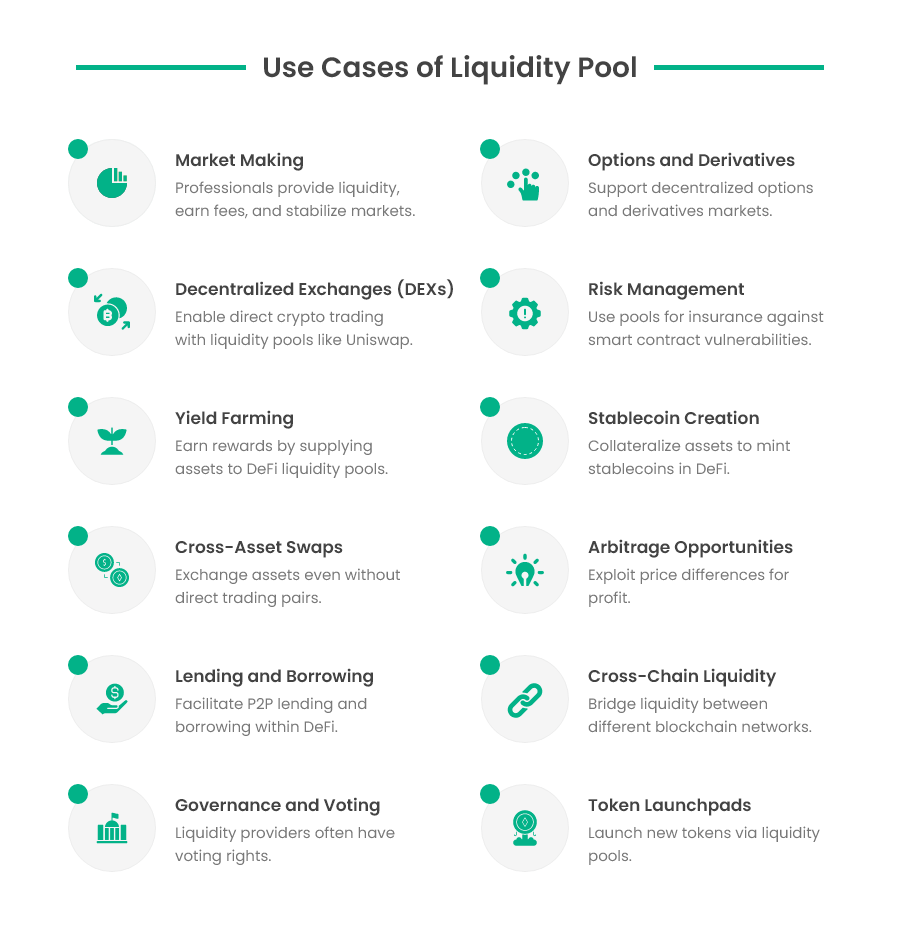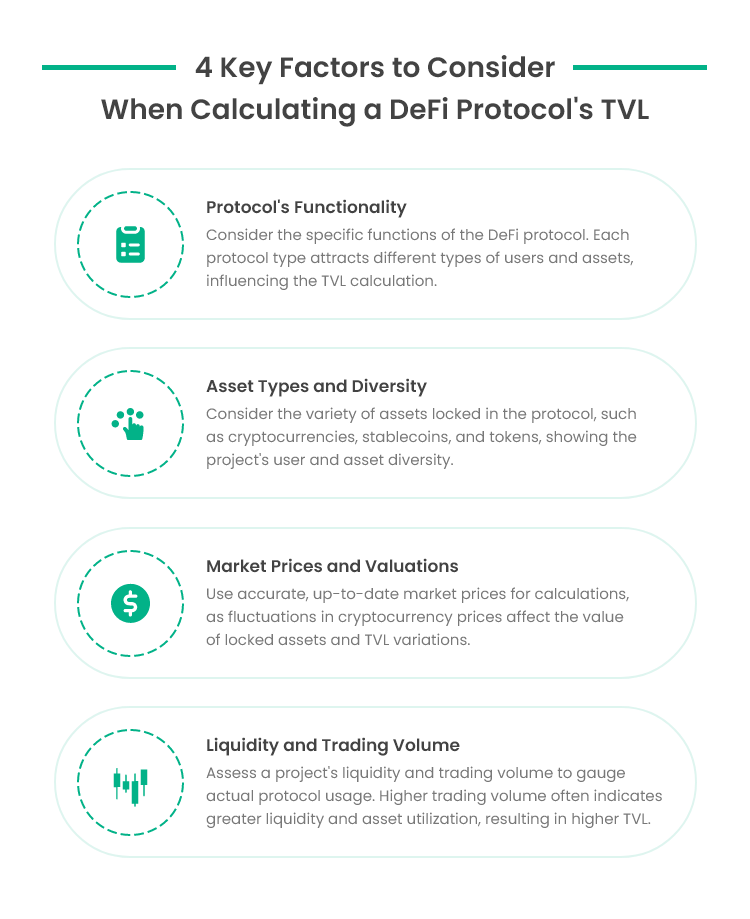This year, the market witnessed a significant boost, with a 60% increase in total market cap. The total value of liquidity in DeFi liquidity pools was over $230 billion, with approx. 6.77 million DeFi users trading annually.
Experts believe that these sudden surges were driven by factors like:





There could be many reasons, but one thing is sure: investors diversify their crypto assets by investing directly in crypto coins and assets like liquidity pools, staking, governance tokens, and yield farming.
Most crypto investors adopt this diversification strategy to maximize returns, manage risk, and participate in a broader DeFi ecosystem.
Since we have mentioned Liquidity Pools, let’s understand their role in a DeFi ecosystem today.
TABLE OF CONTENT
What Are Liquidity Pools?
A liquidity pool is a collection of funds locked in a smart contract. The core purpose of this pool is to facilitate transactions and allow traders to swap between diverse assets within the pool.
Liquidity pools have unique benefits for users by offering them an incentive for their stake in the pool. Let’s say you have added digital tokens to the pool, and to keep it in, you will earn rewards in the form of liquidity provider tokens. The pool holds two or more cryptocurrency tokens in a decentralized exchange, encouraging participants to earn a passive income on their invested coins.
What Exactly Does Liquidity Pools Do?
Liquidity pools offer crypto traders the ability to buy and sell tokens on a decentralized exchange platform without needing a traditional market maker. A smart contract that manages all the trading activities does this resource-intensive work. Moreover, these smart contracts are governed by an automated market maker algorithm (AMM) that mathematically determines the price of each token and adjusts its rates in the real-time economic game of supply and demand. A remarkable feature of Automated Market Maker is that the supply of each token in a pool is always proportional to the other tokens in the pool.
The Working Model of DeFi Liquidity Pool

Liquidity Pool Tokens
So, if you hold crypto tokens in your wallets and want to earn a passive income from them, Liquidity Pool is your best bet. Your reward will be Liquidity Pool Tokens (LPTs), similar to receipts for your pool share.
Ownership of an LPT gives the investor the right to a portion of transaction fees collected from the pool’s activities and any additional benefits that the DeFi platform may offer. Investors can redeem their LPTs for the original assets they placed, together with any accumulated fees or rewards, and remove their liquidity from the pool whenever they choose. Depending on the platform, LPTs may also be called pool tokens (PTs) or LPs.
Things An Investor Can Do With Liquidity Pool Token
As an investor in a liquidity pool, you can generate passive income. When users trade within the pool, they are charged transaction fees, and a portion of it is shared among the liquidity providers. So, your payment will be proportionally based on your stake in the pool.
Ways to Use Liquidity Pools
If you have a risk appetite, then here are some of the methods through which you can generate additional income using the liquidity pools:
-
- Yield farming
-
- Staking
-
- Liquidity Mining
-
- Platform governance
-
- Liquid staking
Importance of Liquidity Pools
Blockchain borrow-lend protocols yield farming, on-chain insurance, and gaming protocols all depend on liquidity pools. Before a transaction can be completed, a buyer and a seller must be paired using traditional financing (TradFi). Conversely, DeFi platforms can automatically execute a deal against the platform’s liquidity pool.
It is significant as it eliminates the requirement for DeFi platforms to match transaction execution prices with projected prices. If the trade’s executed price is higher than anticipated, the buyer will receive fewer tokens, and the seller will receive more tokens. Slippage is the term for this. Hence, to mitigate the losses due to slippage, the pool charges a meagre fee for every transaction and devotes it among liquidity providers in a shared ratio of their stake.
Use Cases of Liquidity Pool

Total Value Locked (TVL)
Usually, DeFi liquidity is expressed as total value locked (TVL). As the name suggests, the TVL is the total value of assets locked in a particular DeFi platform, which includes the volume of cryptocurrency held in smart contracts and any other assets the platform has tokenized.
TVL is a critical metric for DeFi protocols as it indicates investors of a platform’s overall liquidity.
One must consider these four key factors when calculating a DeFi protocol TVL.

Examples of Some Popular Liquidity Pools
Nowadays, many decentralized applications trade digital assets automatically and without permission using liquid asset pools. Liquidity pools have a significant role in DeFi since they supply the liquidity required for the ecosystem to run smoothly and lessen dependency on conventional financial intermediaries.
Here are some of the popular platforms operating on DeFi liquidity pools:
Uniswap: Since new ERC-20 tokens are added to Uniswap regularly, it is a decentralized exchange running on the Ethereum blockchain that allows users to trade any token. There are multiple liquidity pools at Uniswap. They support exchanges for ETH/USDT, ETH/DAI, and ETH/USDC in some of their most well-liked pools.
Curve: Curve is a decentralized exchange that offers low-slippage trading for comparable assets and specialises in stablecoins. The curve has multiple liquidity pools. A few of its most well-liked pools accept USDT/USDC/DAI in addition to BTC/renBTC/wBTC/sBTC.
Balancer: Users of the decentralized exchange can design unique liquidity pools with up to eight tokens. Well-known balancer pools include LINK/ETH, WBTC/renBTC/sBTC, and ETH/USDC/DAI/WBTC.
SushiSwap: A decentralized platform called SushiSwap provides liquidity pools with lucrative agricultural incentives for liquidity suppliers. SushiSwap pools with the highest trade volume include ETH/USDC, ETH/USDT, and ETH/WBTC.
What Can You Except More from DeFi Liquidity Pool?
The DeFi Liquidity pool can open up a passive income source for traders and overcome liquidity challenges. For businesses, the liquidity pool in DEX can attract new traders and create a broader DeFi ecosystem. We are your best bet for state-of-the-art DeFi liquidity solutions. Contact our DeFi experts at info@webmobsoft.com for a free consultation.
FAQs
What is a DeFi Liquidity Pool?
A smart contract-locked collection of cryptocurrency is called a DeFi liquidity pool. Decentralized lending, trading, and other decentralized financial services are made possible via DeFi liquidity pools. Liquidity pools ensure enough liquidity is available for transaction executions by combining assets from several participants.
Are liquidity pools profitable?
Liquidity pools can be profitable, but they also include several risks, such as signifiant monetary loss. Transaction fees from trades inside the pool are the most consistent source of potential revenue for liquidity providers.
What is a DeFi mining pool?
Investing in a DeFi mining pool, sometimes called a liquidity mining pool, entails contributing financial assets in return for incentives that are frequently tokens. Earning new tokens to provide resources is similar to classic mining; only in this case are the resource's liquidity rather than processing power.
How do DEX liquidity pools work?
Digital assets are gathered by decentralized exchange liquidity pools from various contributors. Contributors, also called liquidity providers, earn a portion of the transaction fees from trades made in the pool when they deposit token pairings into it. The fee distribution provides incentives for investments and helps guarantee that the pool has sufficient liquidity to support trade. Each liquidity provider's particular percentage of fees received is usually determined by how much of the pool's total liquidity they account for.
Nitin Gupta, the CEO of WebMob Software Solutions, is a visionary leader renowned for his innovative approaches to leveraging emerging technologies to transform businesses globally. Under Nitin's guidance, WebMob has evolved into a pioneer in fintech, catering to esteemed clients across Europe, APAC, and the Middle East. As a thought leader, he continues to drive WebMob towards new heights of success, cementing its reputation as an industry leader in the IT sector.

